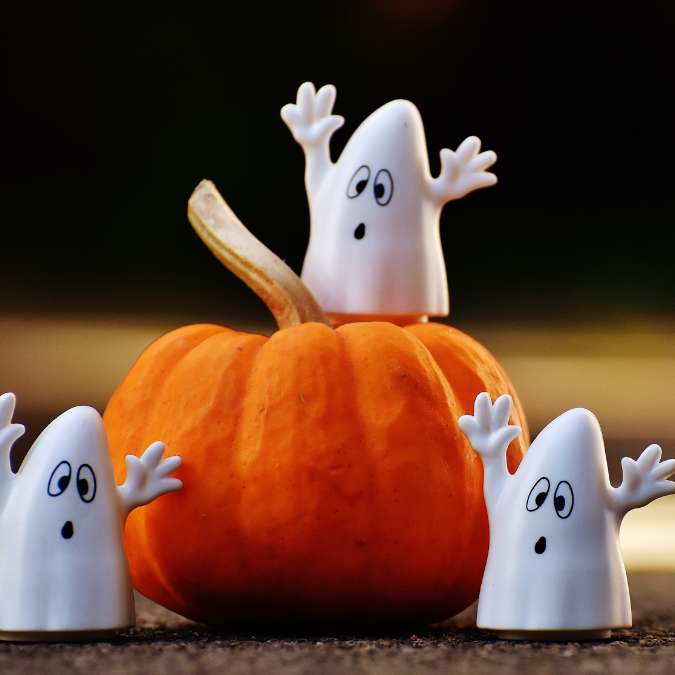
Every year, on the night of October 31, streets fill with carved pumpkins, witches’ hats, skeletons, and black cats. Kids go trick-or-treating, adults dress up for costume parties, and eerie decorations appear everywhere.
But behind the spooky fun and modern traditions of Halloween lies a world of ancient symbols and forgotten meanings. Many of the things we now associate with this night — from the jack-o’-lantern to the color orange — have deep roots in mythology, folklore, and spirituality.
This article will uncover the hidden meanings and origins of the most iconic Halloween symbols — from Celtic rituals to Christian transformations — and show how these elements survived for centuries to become part of one of the world’s favorite celebrations.
Get ready to discover the secrets behind the ghosts, bats, and pumpkins you thought you knew! 👻✨
🎃 The Jack-o’-Lantern: From Celtic Spirits to Carved Pumpkins
Perhaps no symbol represents Halloween better than the jack-o’-lantern — that glowing, toothy pumpkin lighting up windows and doorsteps around the world.
🌕 Ancient Origins in Samhain
The story of the jack-o’-lantern goes back more than 2,000 years to the Celtic festival of Samhain, which marked the end of the harvest season and the start of winter. During Samhain, people believed that the barrier between the world of the living and the dead was thin, allowing spirits to roam freely.
To keep evil souls away, Celts carved faces into turnips or beets and placed candles inside them. These lanterns acted as protective charms to ward off wandering spirits.
🔥 The Tale of Stingy Jack
The pumpkin carving tradition we know today comes from an Irish folktale about Stingy Jack, a man who tricked the Devil and was condemned to wander the earth forever.
Jack’s punishment was to roam in darkness with only a burning coal placed inside a hollowed-out turnip to light his way — hence the name “Jack of the Lantern.”
When Irish immigrants arrived in America in the 19th century, they discovered that pumpkins, native to the New World, were much easier to carve than turnips. Thus, the pumpkin became the new symbol of Jack’s lantern, and an essential part of Halloween.
💡 Hidden Meaning
Beyond decoration, the jack-o’-lantern still symbolizes light overcoming darkness, a reminder that hope and human creativity can keep fear at bay — even on the darkest night of the year.
🕷️ Spiders and Webs: The Threads Between Worlds
Spiders often evoke fear — but on Halloween, they’re everywhere: on costumes, fake cobwebs, and even desserts! So why are spiders such a powerful Halloween image?
🕸️ Ancient Beliefs and Symbolism
In ancient Europe, spiders were seen as mystical creatures — guardians of secrets and symbols of destiny. Their intricate webs represented the cycle of life, fate, and the invisible threads connecting all beings.
During Samhain, people believed that if a spider appeared near a candle or bonfire, it was a sign that the spirit of a loved one was close.
⚖️ Christian and Medieval Interpretations
In the Middle Ages, however, spiders took on a darker image. Because they were associated with witches and the supernatural, seeing one during Halloween was thought to signal the presence of a witch or even the Devil himself.
🕯️ Hidden Meaning
Today, spiders and webs remind us of the fine line between life and death, the mystery of fate, and humanity’s ancient fascination with the unknown. They’re not just creepy — they’re symbols of patience, creation, and the web that ties our world to the spiritual realm.
🦇 Bats: Guardians of the Night
Bats fluttering across the moonlit sky are another classic Halloween image — but they didn’t become spooky by accident.
🌑 Ancient Celtic Associations
During Samhain, large bonfires were lit to ward off evil spirits. These fires attracted insects, which in turn drew bats. Seeing bats flying near these sacred fires made people believe that they were messengers or spirits.
⚰️ The Vampire Connection
By the 18th and 19th centuries, bats had gained a darker reputation thanks to literature. Gothic novels like Dracula (1897) linked bats with vampires, turning them into symbols of darkness, transformation, and eternal life.
🌌 Hidden Meaning
In many cultures, bats actually symbolize rebirth, intuition, and transition. They navigate through darkness with precision, representing the ability to face fear and embrace change — ideas deeply connected to the Halloween spirit.
So, the next time you see a bat decoration, remember: it’s not just a creature of the night — it’s a reminder of how we navigate through our own darkness. 🦇
🧙♀️ Witches: From Wise Women to Halloween Icons
No Halloween would be complete without witches — with their pointy hats, brooms, and black cats. But their story is far deeper than popular imagination suggests.
🌒 The Wise Women of Old
Before witches were feared, they were respected healers and herbalists in pre-Christian Europe. These women — often called “wise women” or “cunning folk” — were connected to nature, the moon, and the spiritual world.
They celebrated Samhain as a sacred time for divination, spellwork, and honoring the ancestors.
🔮 From Healers to Outcasts
With the rise of Christianity, many of these women were labeled as witches and accused of serving the Devil. The witch hunts of the 15th–17th centuries turned them into symbols of evil and rebellion.
Yet, the witch survived — as a powerful archetype of female independence, wisdom, and magic.
🕯️ Hidden Meaning
The witch represents intuition, transformation, and spiritual power. On Halloween, when the boundary between worlds weakens, the witch reminds us of our inner strength and our connection to the unseen.
🐈⬛ Black Cats: Luck, Mystery, and Magic
The black cat — sleek, silent, and glowing-eyed — has been both loved and feared for centuries.
🐾 Ancient Roots
In ancient Egypt, cats were sacred animals, associated with the goddess Bastet, protector of homes and families. Killing a cat was considered a terrible crime.
However, during the Middle Ages, black cats became symbols of witchcraft. It was believed that witches could shape-shift into cats, or that cats were their familiars — magical companions who helped them perform spells.
🍀 Dual Symbolism
While many feared them, others saw black cats as bearers of good fortune. Sailors, for example, believed that bringing a black cat aboard a ship ensured a safe journey.
🌙 Hidden Meaning
The black cat embodies mystery, independence, and intuition. It symbolizes the unseen, reminding us that not everything dark is dangerous — sometimes, it’s simply misunderstood.
💀 Skeletons and Skulls: The Dance Between Life and Death
Skeletons are everywhere during Halloween — from costumes to candy wrappers. But they are far more than decorations.
⚰️ Ancient and Religious Symbolism
Skeletons have long been symbols of mortality and the impermanence of life. In medieval Europe, “memento mori” art — Latin for “remember you must die” — used skulls to remind people of life’s fragility.
In Mexico, skeletons take on a very different meaning during the Día de Muertos (Day of the Dead) celebrations. There, they symbolize joyful remembrance, showing that death is a continuation, not an end.
🌼 Hidden Meaning
The skeleton is one of Halloween’s most profound symbols: it invites us to accept death as part of life, to laugh at fear, and to remember that beneath the mask, we are all the same.
🕯️ Candles and Lanterns: Lighting the Way Between Worlds
Candles are another common Halloween decoration — but their roots are deeply spiritual.
🔥 Ancient Fire Rituals
During Samhain, Celts lit large bonfires to guide the spirits of ancestors and protect their communities from harm. Later, during All Souls’ Day, Christians placed candles on graves to help guide the souls of the dead to heaven.
✨ Hidden Meaning
A candle’s flame represents hope, remembrance, and eternal light. On Halloween night, every candle burning in a window recalls the ancient belief that light can protect, guide, and connect the living with the dead.
🧛 Monsters, Ghosts, and Ghouls: The Shadows of Human Fear
No Halloween is complete without monsters. From vampires and zombies to ghosts and demons, they embody humanity’s oldest anxieties.
👻 Ghosts
Ghosts symbolize the souls of the departed — messengers from the other side. In many cultures, they return not to scare, but to seek closure or remembrance.
🧟 Zombies
Zombies, though modern in pop culture, reflect fear of loss of control and mortality — themes that fit perfectly with Halloween’s reminder of life and death.
🧛 Vampires
Vampires, tied to bats and darkness, represent the eternal struggle between desire and morality, as well as the ancient fear of what lies in the night.
🌘 Hidden Meaning
Together, these creatures remind us that our deepest fears reveal our greatest truths — the need to face mortality, understand our nature, and embrace the unknown.
🧡 The Colors of Halloween: Orange and Black
Even the colors of Halloween carry symbolic meaning.
- Orange stands for warmth, harvest, and fire — the color of autumn leaves and glowing pumpkins. It represents life and celebration.
- Black, on the other hand, symbolizes night, mystery, and the afterlife. It’s the color of mourning but also of rebirth and transformation.
Together, they perfectly capture Halloween’s essence: the meeting of life and death, light and darkness. 🎨
🎭 Masks and Costumes: The Power of Transformation
Finally, one of Halloween’s most exciting traditions — dressing up — has deep historical meaning.
During Samhain, Celts wore animal skins and masks to disguise themselves from evil spirits wandering the earth. Later, in the Middle Ages, people dressed as ghosts or saints while going door-to-door collecting food — a practice that evolved into trick-or-treating.
🕸️ Hidden Meaning
Masks and costumes symbolize transformation and liberation. On Halloween, we step into another identity, exploring our hidden selves and conquering our fears — just as our ancestors once did when they faced the long, dark nights of winter.
🌕 Conclusion: The Real Magic of Halloween
Behind every pumpkin, ghost, and witch lies a story — a symbol born from centuries of fear, faith, and fascination.
Halloween isn’t just about candy or costumes. It’s about honoring ancient traditions, embracing transformation, and finding meaning in the mysteries of life and death.
So, next time you light a jack-o’-lantern, spot a black cat, or hang a paper bat in your window, remember: you’re not just decorating. You’re participating in a ritual that connects you to generations past — a celebration of light, darkness, and the enduring power of the human spirit. 🌕🎃✨
Sources:
- BBC History: The Origins of Halloween (2024)
- Smithsonian Magazine: The Story of the Jack-o’-Lantern (2023)
- National Geographic: Ancient Samhain and Modern Halloween Traditions (2024)
- Encyclopedia Britannica: Halloween Symbols and Their Meanings
- History.com: Why We Carve Pumpkins on Halloween (2024)

